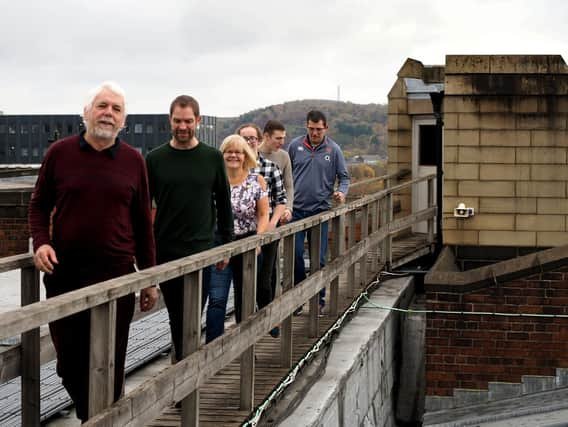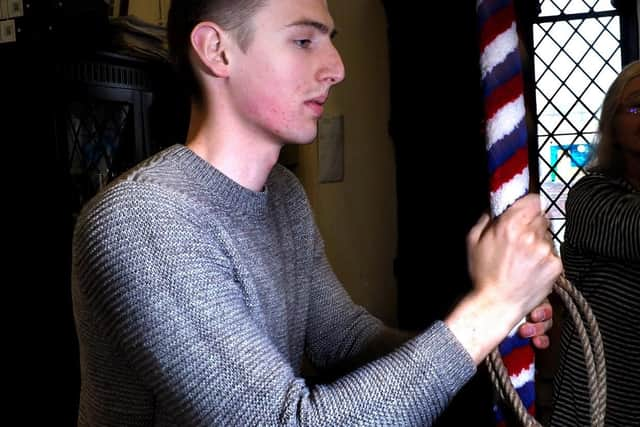Feature: Ringing to remember with '˜joyous' sound of tradition


During their practice evening last Thursday, however, the Sheffield Cathedral bell ringers had scaled the bell tower to fit leather pads to '˜half-muffle' the bell clappers for the Sunday morning service. 'It gives an echo, an atmospheric and mournful sound, appropriate to Remembrance Sunday,' said Sheffield Cathedral ringing master Simon Reading. The '˜band' at the city's Anglican Cathedral were ringing twice last Sunday, for the morning service and then alongside ringers in over 3,000 bell towers across the country to celebrate the 100th anniversary of the Armistice of 1918. (The spontaneous ringing of Britain's church bells was one of the government-approved ways to let the population know the war was over on November 11th 1918). Sunday saw the culmination of the '˜Ringing Remembers' initiative set up by the Central Council of Church Bell Ringers and the government to recruit 1,400 new bellringers who could then join the Armistice Remembrance Day ringing, in commemoration of the 1,400 British and Commonwealth bell ringers who died in the forces between 1914 and 1918. Although no Sheffield Cathedral ringers died during the war, bands at Bolsterstone, Ranmoor, Beighton and Dore were remembering predecessors killed in action who once rang in the same towers. 'We have three new recruits who have been training so they can ring today,' Simon Reading said.
Carole Kerrigan, Diane Smith and Maria Di Domenico are the new Cathedral ringers. 'I was looking into my family history and discovered that two of my great uncles died in World War One, and I thought learning to ring these bells would be a fabulous way to remember them, and all the fallen,' said Carole.


Advertisement
Hide AdAdvertisement
Hide Ad'To me, it's a real honour to be able to do this.' All local ringing bands are usually keen to meet potential new members, Simon said, adding that there is no lack of interest these days, with retired people learning the craft, as well as children of ringers and students taking up the ropes in their new cities. 'Bellringers are usually very open and friendly,' said student Joe Waters, who joined the Cathedral ringers after moving to Sheffield University from Lincolnshire.
'And once you've learned you can carry on anywhere.' On Sunday afternoon, after ringing a series of short '˜touches' in Sheffield, Simon Reading was off to Chesterfield to take part in a full '˜peal' of bells lasting three hours. 'You need real focus and concentration to ring a peal, you can't think of anything else, but you enjoy it because it's a wonderful sound being produced,' he said.
Simon has rung over 1,000 peals over the last fifty years, he said, 'often just for the fun of it!' He said the key traits needed by bell ringers are a sense of rhythm and the ability to concentrate.
New ringers are asked to train for at least an hour a week, and usually after a few months they'll be ready for action alongside the 2,400 new ringers already recruited through Ringing Remembers. The band at Sheffield Cathedral recently installed a new treble bell to add to the 12 larger bells that have rung out from the Cathedral since the 1970s. The smaller bell is easier to ring for beginners. '˜Change ringing' as practised by bellringers in British and some overseas churches originated in the early 1600s, but modern towers like the Cathedral have moved with the times to install computer software to measure the accuracy of their ringers. 'A really good ringer can be accurate to 20 milliseconds,' said Simon. That is, 1/50 of a second. He advises people interested in taking up the art to contact either the Cathedral or their local ringing church tower.


Advertisement
Hide AdAdvertisement
Hide AdThere have been concerns about lack of ringers in recent years, but Simon is optimistic. 'It really is a glorious sound, and most people really like it,' he said.
'I don't think we're in any danger of losing bell ringing in England.' For more information, or to make contact with the Cathedral group, visit www.sheffieldcathedral.org/bells-and-bell-ringers/